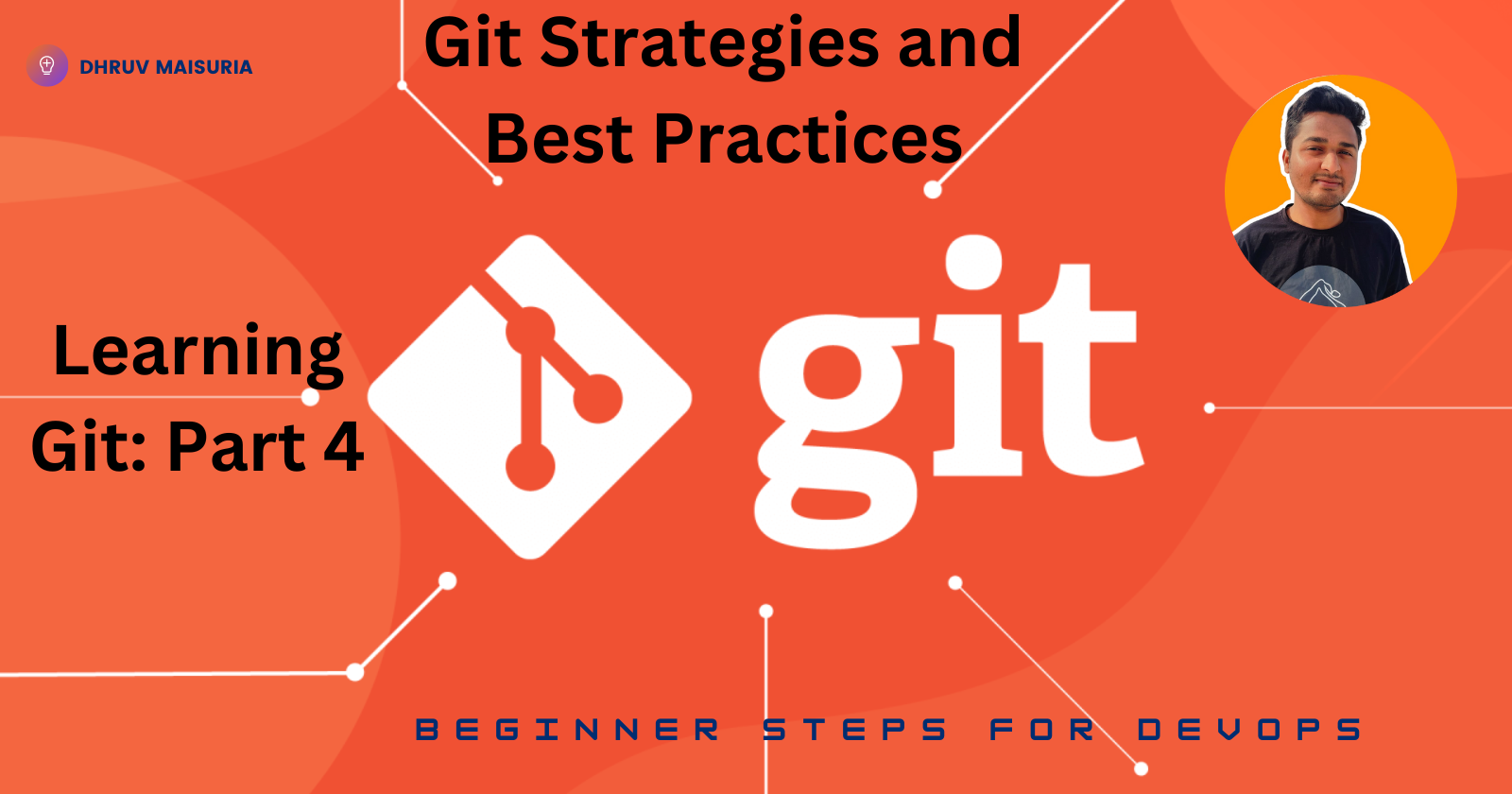Learning Git: Part 4
 Dhruvkumar Maisuria
Dhruvkumar Maisuria
Introduction
Welcome to the fourth part of our DevOps learning series! In the previous parts, we covered Git basics, branching and merging, and advanced Git concepts. Now, we'll explore Git strategies and best practices to help you manage your code more efficiently and collaborate effectively with your team.
Git Branching Strategies
Branching strategies are essential for maintaining a clean and organized repository. Here are some popular branching strategies:
1. Git Flow
Git Flow is a robust branching model that provides a standard approach for managing feature development and releases. It consists of the following branches:
Main: The main branch contains production-ready code.
Develop: The develop branch serves as the integration branch for features and contains the latest delivered development changes.
Feature: Feature branches are created from the develop branch to work on new features.
Release: Release branches are created from the develop branch to prepare a new production release.
Hotfix: Hotfix branches are created from the main branch to fix critical bugs in production.
Git Flow Commands
Create a new feature branch:
git checkout -b feature/feature-name developFinish a feature branch:
git checkout develop git merge feature/feature-name git branch -d feature/feature-nameCreate a release branch:
git checkout -b release/release-version developFinish a release branch:
git checkout main git merge release/release-version git tag v1.0 git branch -d release/release-versionCreate a hotfix branch:
git checkout -b hotfix/hotfix-name mainFinish a hotfix branch:
git checkout main git merge hotfix/hotfix-name git tag v1.0.1 git branch -d hotfix/hotfix-name
2. GitHub Flow
GitHub Flow is a simpler alternative to Git Flow, suitable for smaller teams and continuous deployment. It consists of the following steps:
Create a branch from main for new work.
Commit changes to the branch.
Open a pull request to merge the branch into main.
Review and approve the pull request.
Merge the pull request into main and deploy.
GitHub Flow Commands
Create a new branch:
git checkout -b feature-branchPush the branch to the remote repository:
git push origin feature-branchCreate a pull request and merge changes on GitHub.
Best Practices for Using Git
1. Commit Often and Write Meaningful Commit Messages
Frequent commits with descriptive messages make it easier to track changes and understand the history of a project.
Good commit message:
Add user authentication moduleBad commit message:
Update code
2. Use Branches Effectively
Create branches for new features, bug fixes, and experiments. Merge branches back into the main or develop branch only when they are stable and tested.
3. Keep Your Repository Clean
Delete branches that are no longer needed to keep the repository clean and organized.
4. Use Tags for Releases
Tagging commits for releases makes it easy to track and identify versions of your code.
git tag -a v1.0 -m "Version 1.0"
git push origin v1.0
5. Code Reviews and Pull Requests
Conduct code reviews through pull requests to ensure code quality and catch potential issues before merging changes into the main branch.
6. Automate Testing and Deployment
Integrate continuous integration (CI) and continuous deployment (CD) tools to automate testing and deployment processes. This ensures that your code is tested and deployed consistently.
7. Use .gitignore
Create a .gitignore file to exclude files and directories that should not be tracked by Git, such as build artifacts, environment files, and dependencies.
Example .gitignore file:
# Node.js
node_modules/
# Python
__pycache__/
*.pyc
# Environment variables
.env
# Build artifacts
dist/
build/
Conclusion
In this part, we've explored Git strategies and best practices to help you manage your code more effectively. By following these strategies and best practices, you can ensure a clean and organized repository, streamline your development workflow, and collaborate efficiently with your team.
Stay tuned for the next part, where we'll delve into advanced collaboration techniques and integrating Git with other tools in your DevOps workflow.
Estimated Time to Complete: 2-3 hours
This blog is part of our DevOps learning series. For more articles, visit my Devops with dhruv09 Page.
If you have any questions or need further clarification on any of the steps, please feel free to reach out. Happy coding!
Next Up: Part 5 - Advanced Collaboration Techniques with Git
Remember to follow our series to keep up with the latest updates and learning materials in DevOps!
Stay connected and keep learning!
Author: [ DHRUVKUMAR MAISURIA ]
GitHub: GitHub Profile
Hashnode: Hashnode Profile
LinkedIn: LinkedIn Profile
Subscribe to my newsletter
Read articles from Dhruvkumar Maisuria directly inside your inbox. Subscribe to the newsletter, and don't miss out.
Written by

Dhruvkumar Maisuria
Dhruvkumar Maisuria
About Me As a dedicated tech enthusiast with a passion for continuous learning, I possess a robust background in software development and network engineering. My journey in the tech world is marked by an insatiable curiosity and a drive to solve complex problems through innovative solutions. I have honed my skills across a diverse array of technologies, including Python, AWS, SQL, and Golang, and have a strong foundation in web development, API testing, and cloud computing. My hands-on experience ranges from creating sophisticated applications to optimizing network performance, underscored by a commitment to excellence and a meticulous attention to detail. In addition to my technical prowess, I am an avid advocate for knowledge sharing, regularly contributing to the tech community through blogs and open-source projects. My proactive approach to professional development is demonstrated by my ongoing exploration of advanced concepts in programming and networking, ensuring that I stay at the forefront of industry trends. My professional journey is a testament to my adaptability and eagerness to embrace new challenges, making me a valuable asset in any dynamic, forward-thinking team. Whether working on a collaborative project or independently, I bring a blend of analytical thinking, creative problem-solving, and a deep-seated passion for technology to every endeavor.